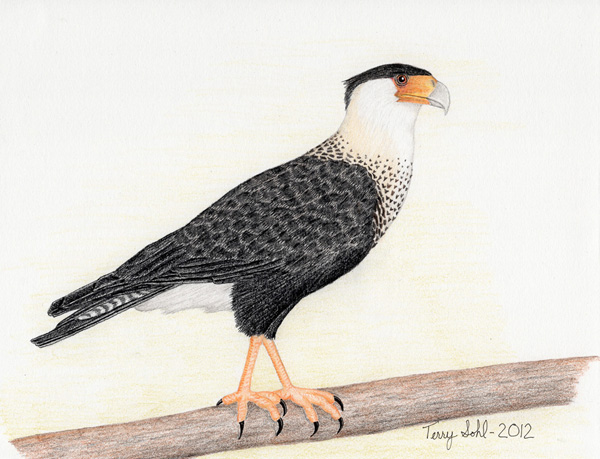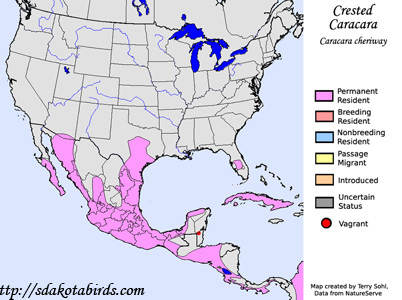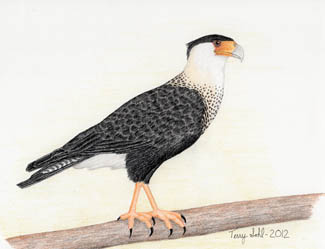| Length: 22-24 inches | Wingspan: 50 inches | Seasonality: Extremely rare visitor |
| ID Keys: Distinctive, with large bill, orange-red face and bill with gray tip, creamy or white head neck and breast with black cap | ||
 The
Crested Caracara is related to falcons, but looks and behaves much differently
than most other falcons. Rather than a aerial hunting specialist
like it's falcon relatives, the Crested Caracara instead is often a carrion
feeder. It is typically a bird of the tropics, only entering the U.S. in
Florida, Texas, or Arizona, although on occasion it will wander north of it's
regular range.
The
Crested Caracara is related to falcons, but looks and behaves much differently
than most other falcons. Rather than a aerial hunting specialist
like it's falcon relatives, the Crested Caracara instead is often a carrion
feeder. It is typically a bird of the tropics, only entering the U.S. in
Florida, Texas, or Arizona, although on occasion it will wander north of it's
regular range.
Habitat: Typically feeds over open areas, but roosts and nests in cover. Typical open habitat for hunting includes prairies and rangeland, desert, or open marshes.
Diet: Much of its food is obtained as carrion, although it will also capture a wide variety of live prey, including ground squirrels, rabbits, lizards, snakes, other small vertebrates, and large insects.
Behavior: Crested Caracara are opportunistic, using a wide variety of methods for foraging and feeding. Often searches for carrion in flight, and has adapted to a human presence by learning to fly along highways in search of roadkill. When hunting for live prey, will typically fly low over the ground to surprise prey.
Nesting: Builds nests of sticks and other plant material, typically in tall shrubs or trees, also sometimes on large cacti. Nests can get quite large, as mating pairs of Crested Caracara often use the same nest year after year, with new material added each year.
Breeding Map: Non-breeder in South Dakota
Song: Usually quiet, although will occasionally vocalize with low croaking
Migration: Territorial, with adult birds typically staying in the same territory. Juvenile birds may wander widely however.
Interactive eBird Map: Click here to access an interactive eBird map of Crested Caracara sightings
Similar Species: Distinctive and easily identified
Conservation Status: Generally stable, with recent increases in some areas and declines in others.
Further Information: 1) Patuxent Bird Identification InfoCenter: Crested Caracara
2) Whatbird.com: Crested Caracara
3) Audubon Guide - Crested Caracara
Image Information: Colored pencil drawing by Terry Sohl - February 2012
| Click on the map below for a higher-resolution view |
 |
| South Dakota Status: Extremely rare visitor to the state |
Additional Crested Caracara Images

